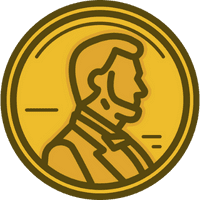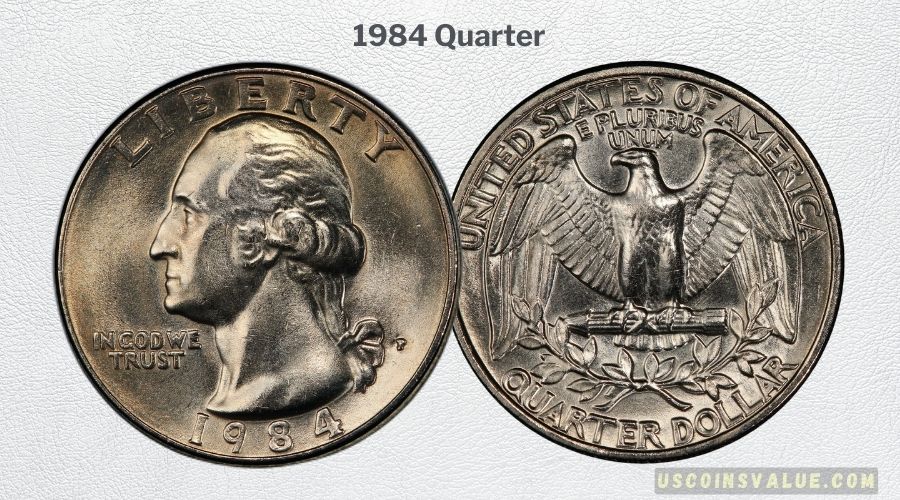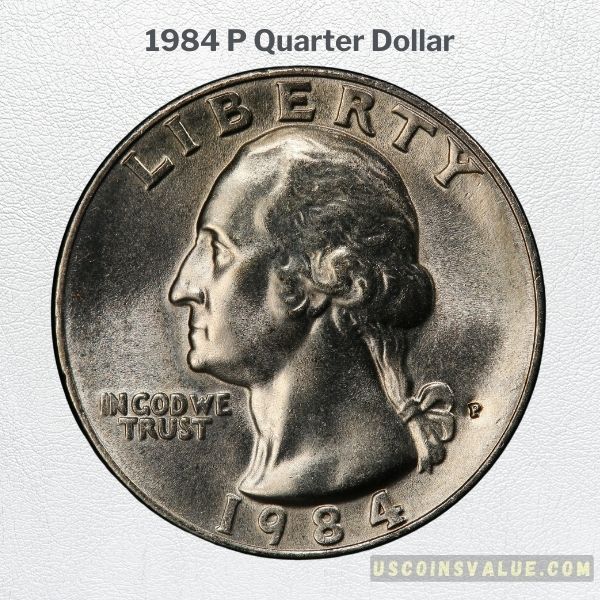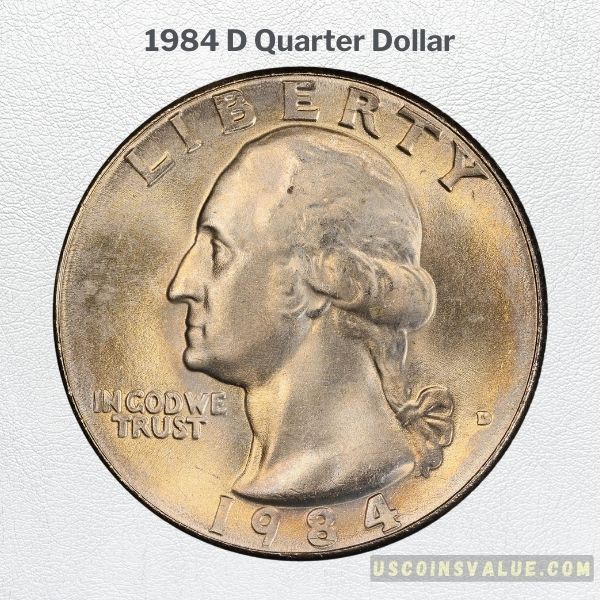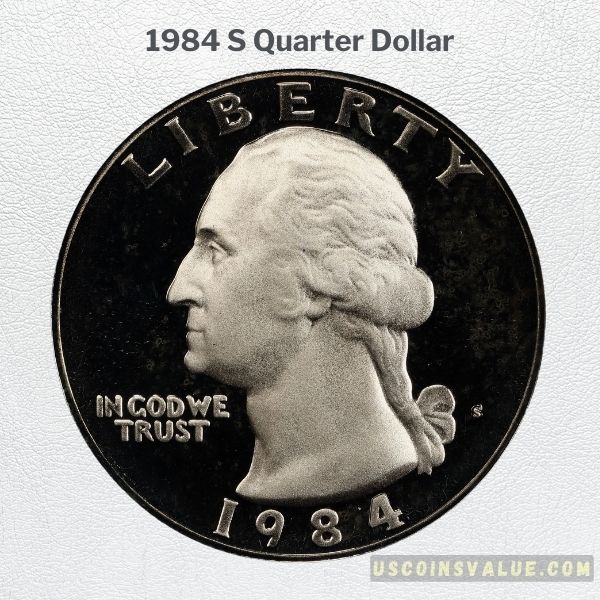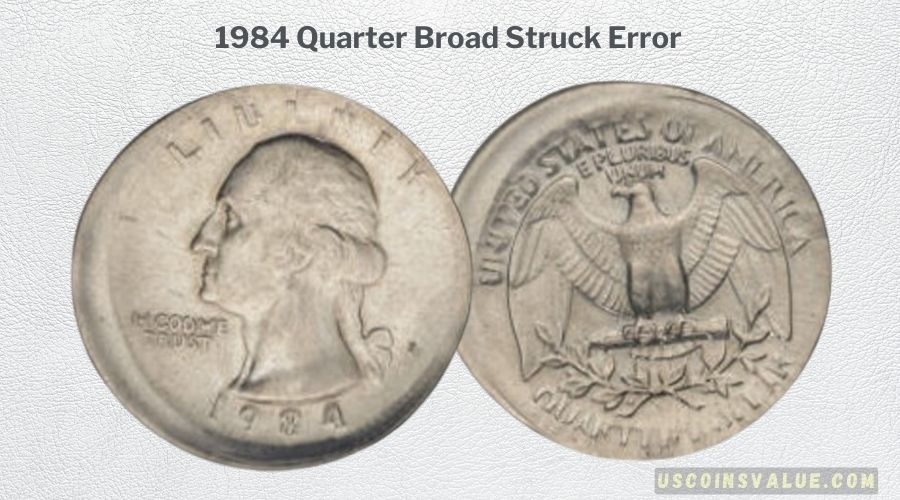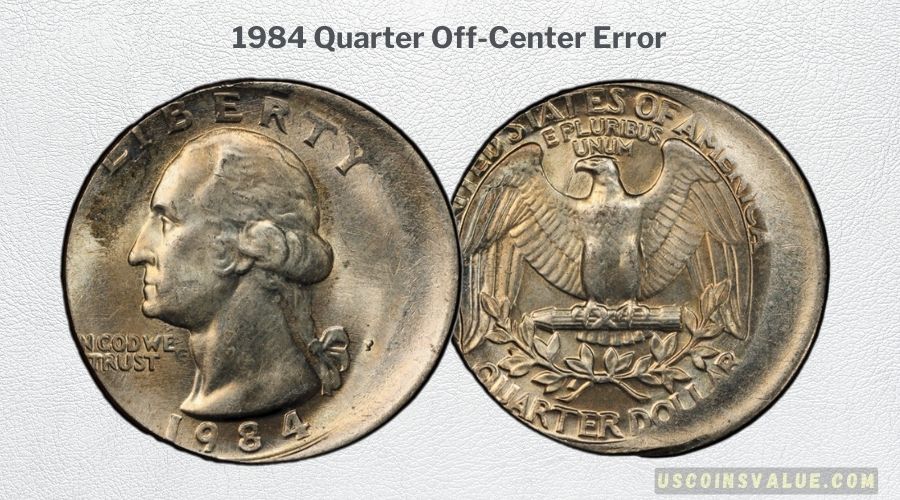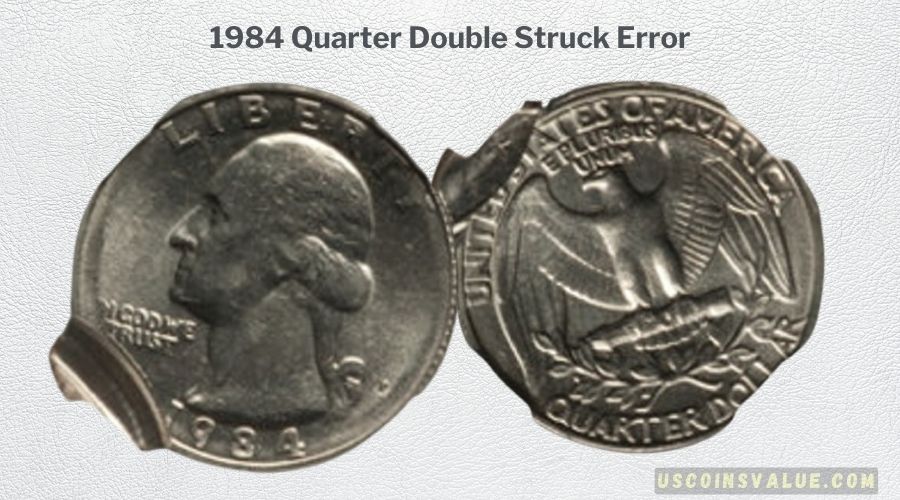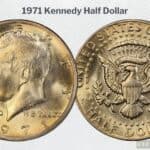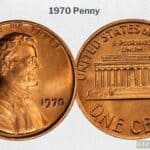What’s the value of the common 1984 Washington Quarter?
The answer is simple – $0.25.
However, this value only applies to coins in circulation. Uncirculated specimens, on the other hand, sell for around $1 to $3 when free or distracting marks or spots.
But in 2018, an unusual 1984-P quarter from Philadelphia mint commanded 1,528 at Heritage Auctions. And even this year, in April, a 1984-D coin garnered an impressive $336.
So, don’t just overlook the 1984 coins in your change jars – you never know what decade-long secrets they hide.
That said, let’s revisit the history and design of the humble 1984 quarter while highlighting the value of its variants.
History of the 1984 Washington Quarter?
Without a doubt, George Washington is a legendary figure. His military leadership and principle-based vision propelled America to greater heights. In fact, his death in 1799 united more Americans than ever before.
Considering all his achievements, it made sense for the country to honor him on his 200th birthday. In 1932, the government decided to place a portrait of the Founding Father on a commemorative US coin for circulation.
Interesting, initial plans focused on the half-dollar and gold-dollar options. But the quarter ultimately prevailed bearing Washington’s portrait.
The treasury department sponsored a competition to find the best design of Washington to replace the figure of Liberty on the circulating quarter. Eventually, they settled on John Flanagan’s design based on the recreation of Jean-Antonie Houdon’s marble portrait sculpture.
The US Mint began the production of the new silver Washington Quarters immediately, releasing them into circulation by August 1st, 1932. Like the Standing Liberty quarter, the new quarter maintained a composition of 90% silver and 10% copper.
However, due to rising silver prices, the Mint dropped the quarter’s original composition in favor of a clad composition (75% copper and 25% nickel) in 1964.
Fast forward to 1984, the Washington Quarter featured the same metal composition. But it was more popular than any other circulating US coin. Even today, the coins stand firmly entrenched in commerce and culture, continuously paying homage to the Nation’s father.
What’s the Total Mintage of the 1984 Washington Quarters?
The 1984 Silver Quarter has been in circulation for 39 years and includes a few varieties. But how many pieces got minted for the series?
Well, the table below breaks down the 1984 quarter mintage information.
| Mint | Mintage | Mint Mark |
| Philadelphia | 775,818,962 | P |
| Denver | 546,483,064 | D |
| San Francisco | 3,065,110 | S |
| Total | 226,270,788 |
What Are the Features of the 1984 Washington Quarter?
- Category: Washington Quarters
- Type: Type 2, Clad (1965–1998
- Mint: Philadelphia, Denver, San Fransico
- Mintage: 226,270,788
- Obverse/Reverse Design: John Flanagan
- Composition: 75% copper, 25% Nickel
- Weight: 5.67g
- Diameter: 24.3mm
- Edge: Reeded
- Face Value: $0.25 (25 cents)
Front View
With the basic details of the 1984 quarter out of the way, let’s discuss its design.
As mentioned before, this 25-cent silver dollar features a bust portrait of George Washington facing left.
Here’s a little detail most people often miss.
The founding father in the image has his trademark long hair, with the lower part of the hair tied using a bow in the back.
His lips also curl into a subtle smile, while the creases along his chin and neck reflect the solemn wisdom of leadership.
The word “IN GOD WE TRUST” flanks the right side of the coin, while the phrase “LIBERTY” anchors above Washington’s head.
Just below his bust sits the production year “1984”. You will also notice a small mint mark “P”, “D” or “S” over his shoulder, signifying the mintage location.
Back View
As for the reverse, the quarter coin rocks the proud American bald eagle facing right. The bird has its wings spread out to symbolize freedom. It’s also perched on a bundle of arrows framed at the bottom with two olive branches.
Above the eagle’s head lies the Latin motto “E PLURIBUS UNUM” written in two lines. Curving around the coins are the words “UNITED STATES OF AMERICA” and “QUARTER DOLLAR”.
How Much Is The 1984 Quarter Worth?
Before we discuss how much 1984 silver dollar costs, here’s a chart that breaks down its value based on mint mark and conditions.
| 1944 Quarter Value Chart | |||
| Mint Mark/ Condition | Circulated | Uncirculated (MS60- MS66) | MS67–MS69 |
| 1984 “P” Washington Quater | $0.25 – $0.50 | $1.00 – $10.00 | $500+ |
| 1984 “D” Washington Quarter | $0.25–$0.50 | $1.50 – $20.00 | $700+ |
| 1984 “S” Washington Quater | $0.25 – $0.50 | $5.00 – $25.00 | $100+ |
1. 1984 “P” Quarter Dollar Value
As the longest-operating facility in the US, the Philadelphia Mint struck over 700 million quarters in 1984. It arguably recorded the highest production that year across all three minting centers.
The Philadelphia Washington Quarters are identified by their “P” mintmark located on the left side of Washington’s portrait.
Due to the high mintage, the 1984-P silver dollars are readily available and commonly found in circulation.
Most circulated pieces (in Very Good condition or lower) display tiny abrasions and micro-dents. You will also notice that their designs appear flattened from years of use but not fully faded. These pieces often retain at $0.25 to $0.50.
But certified 1984-P silver quarters at MS60-MS63 grade with light bag marks and abrasion can trade for $1. At MS 65-MS 66, examples showcase glowing luster and sharply struck designs, which draw collectors to value them at $3 to $10.
At superb gem grades of MS67 through MS69, specimens become super rare and their value dramatically increases to more than $25. One example sold for $576 in 2018 at Heritage Auctions.
Here are other examples:
| Grade | Price | Firm | Date |
| MS66 | $36 | Heritage Auction | Mar-2013 |
| MS67 | $540 | Heritage Auctions | May-2019 |
| MS67 | $280 | Davide Lawrence RC | Apr-2023 |
| MS67 | $432 | Heritage Auctions | May-2019 |
2. 1984 “D” Quarter Dollar Value
The Denver Mint supplies over 540 million 1984 quarters, falling second in production behind Philadelphia.
Like their 1984-P cousins, coins from Denver bear a unique “D” mint mark. They are also readily accessible even 39 years later, thanks to the considerable numbers which entered circulation.
However, the vast majority of the 1984-D quarter available today grade no higher than Very Good grade. Most display microscopic digs and tiny abrasions from continuous usage. Surprisingly, Washington’s profile and the eagle’s design remain identifiable, even if flattened.
In circulated condition, 1984-D coins trade hands at just $0.25 to $0.50 apiece. But in uncirculated conditions, the story shifts because examples display fewer signs of wear. This applies to quarters grades at MS60 through MS65, which usually fetch anywhere from $1 to $20.
If you move to MS66 and above, 1984-D Washington Silver coins have virtually pristine strikes and surfaces. At this grade, these quarters become elite trophies, with their values leapfrogging to $500+.
Record sales show that the most expensive 1984-D sold for $780 at Heritage Auctions in 2019–a testament to its conditional rarity.
Other examples include:
| Grade | Price | Firm | Date |
| MS67 | $336 | Heritage Auctions | Apr-2023 |
| MS67 | $764 | Heritage Auctions | Sep-2013 |
| MS67 | $423 | Heritage Auctions | Apr-2023 |
3. 1984 “S” Quarter Dollar Value
The San Francisco minting facility produced just over 3 million Washington Quarters in 1984 for collectors.
This low mintage adds an aspect of rarity to the 1984-S coins, which captures the interests of numismatics and coin enthusiasts who want unique pieces for their collections.
Although a handful exist, the 1984-S silver dollars demand a low premium compared to regular strikes. Examples are easily found and are affordable up to PR-65 deep cameo. At an auction, these pieces can sell for around $5.
Specimens in PR67 are relatively common and display few microscopic imperfections. However, their value increase, with examples fetching around $30 or more for their near-pristine condition.
From PR69 to PR70, 1984-S displays absolute perfection and gets valued at $90 or more.
According to sales recorded, the most expensive 1984-S fetched an impressive $380 at auction, thanks to its super gem grade of PR-67.
| Grade | Price | Firm | Date |
| PR70DCAM | $22 | David Lawrence | May-2020 |
| PR70 | $50 | Heritage Auctions | Aug-2015 |
| PR70 | $80 | Heritage Auctions | May-2013 |
| PR70 | $83 | Great Collections | Jul-2012 |
Do 1984 Washington Quarter Have Errors?
Most Washington Quarters were not immune to minting errors. The 1984 series is no different. In this section, we will highlight several 1984 quarter errors you might encounter.
1. 1984 Quarter Broad Struck Error
Kickstarting our list is the broad-struck error. It occurs when the quarter is struck without the collar that holds it in place during minting.
In the 1984 quarter, the broad stuck error presented itself in the following ways:
- A flatter and wider coin than a typical Washington quarter
- Missing ridges or incomplete reading along the edge
- Distorted or stretched design features in the flatter areas of the coin, especially near the rim
More dramatic cases of the coin error can also exhibit:
- The center of the coin might appear puffed up, forming something like a dome
- Raised design elements toward the center
- Irregular shape beyond the normal coin diameter
The severity of the broadstruck error determines the overall value of the coin. Often, coins that maintain complete design features near the center demand high prices in the market.
Here are a few examples of the 1984 silver dollar with broadstruck error:
- 1984 Quarter Broadsruck MS63 ANACS – sold for $11
- 1984-P 25c Washington Quarter Broadstruck MS64 – sold for $16 in April 2006
2. 1984 Quarter Stuck Off-Center Error
In Washington Quarters the off-center error happens when a blank planchet is not center aligned. As a result, the coin’s design is printed off from the center.
Most coins with this error often miss some details. They also include these characteristics:
- A blank surface on the coin shifted to one side
- Visible design features are slightly off from the true center
The severity of the error is measured by the percentage of the missing design, generally 10% to 15%.
But in extreme situations, some quarters can have up to 75% off-center errors. In this case, you can only see a narrow band of the overall design. However, critical elements like the date and mint mark might be visible.
Like broadstruck error coins, the value of the off-center error coins varies depending on severity. However, factors like eye appeal and preservation of key details might come into play.
This table highlights a few recorded sales of the 1984 Quarter Off-Center error. Check it out!
| Grade | Variety | Degree of Off-Center | Auction House | Price |
| NA | 1984-P | 50% | Heritage Auctions | $69 |
| AU50 | 1984-P | 10% | Heritage Auctions | $99 |
| AU58 | 1984-D | 65% | Heritage Auctions | $99 |
| MS62 | 1984-D | 80% | Heritage Auctions | $169 |
| MS63 | 1984-P | 15% | Heritage Auctions | $55 |
| MS64 | 1984-P | 5% | Heritage Auctions | $31 |
| MS66 | 1984-P | 10% | Heritage Auctions | $84 |
3. 1984 Quarter Double Struck Error
Another error worth talking about is the 1984 quarter double-struck error. As the name suggests, this error occurs when a coin is struck more than once by the minting dies.
Coins with this error feature overlapping images, text, or design details. Some error coins might have a distinct separation between overlapped design elements and a clear doubling of the date and mottoes.
Quarters with this type of error stand out and fetch slightly higher prices than regular strikes. For example, a collector paid $162 for the 1984-P quarter double struck graded at MS 64. However, this high price tag also resulted from a second error–a strike off-center.
Besides this error, watch out for these errors:
- 1984 Quarter Over-struck Date Error – It happens when debris builds up on the dies during minting. This causes a weakly struck date.
- 1984 Quarter Missing Letter Error – Due to minting accidents, some Washington Quarters can miss some inscriptions like mintmarks or words in the motto “IN GOD WE TRUST”.
Closing Thoughts
At first glance, a tiny, old 1984 Washington quarter dug out of your pocket change may not seem valuable.
However, some exceptional 1984 silver quarters have aged more gracefully than others. They still retain their pristine look nearly 40 years later. Because of their unique appearance, collectors and enthusiasts alike sought them out.
In auctions, uncirculated, rare pieces could sell for as much as $500. Add the element’s unique errors and flawless condition and you could see their value increasing exceptionally up to thousands of dollars.
So, don’t just throw your pocket change in the jar. Be on the lookout for unique or untouched specimens. You will be surprised with what you can uncover.
